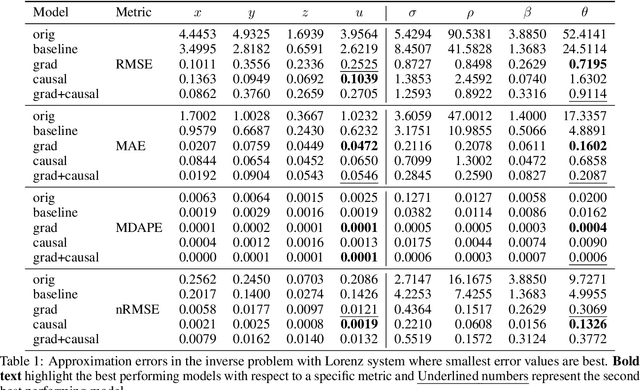Dinh Viet Cuong
Physics-Based Dynamic Models Hybridisation Using Physics-Informed Neural Networks
Dec 10, 2024Abstract:Physics-based dynamic models (PBDMs) are simplified representations of complex dynamical systems. PBDMs take specific processes within a complex system and assign a fragment of variables and an accompanying set of parameters to depict the processes. As this often leads to suboptimal parameterisation of the system, a key challenge requires refining the empirical parameters and variables to reduce uncertainties while maintaining the model s explainability and enhancing its predictive accuracy. We demonstrate that a hybrid mosquito population dynamics model, which integrates a PBDM with Physics-Informed Neural Networks (PINN), retains the explainability of the PBDM by incorporating the PINN-learned model parameters in place of its empirical counterparts. Specifically, we address the limitations of traditional PBDMs by modelling the parameters of larva and pupa development rates using a PINN that encodes complex, learned interactions of air temperature, precipitation and humidity. Our results demonstrate improved mosquito population simulations including the difficult-to-predict mosquito population peaks. This opens the possibility of hybridisation concept application on other complex systems based on PBDMs such as cancer growth to address the challenges posed by scarce and noisy data, and to numerical weather prediction and climate modelling to overcome the gap between physics-based and data-driven weather prediction models.
Adapting Physics-Informed Neural Networks To Optimize ODEs in Mosquito Population Dynamics
Jun 07, 2024



Abstract:Physics informed neural networks have been gaining popularity due to their unique ability to incorporate physics laws into data-driven models, ensuring that the predictions are not only consistent with empirical data but also align with domain-specific knowledge in the form of physics equations. The integration of physics principles enables the method to require less data while maintaining the robustness of deep learning in modeling complex dynamical systems. However, current PINN frameworks are not sufficiently mature for real-world ODE systems, especially those with extreme multi-scale behavior such as mosquito population dynamical modelling. In this research, we propose a PINN framework with several improvements for forward and inverse problems for ODE systems with a case study application in modelling the dynamics of mosquito populations. The framework tackles the gradient imbalance and stiff problems posed by mosquito ordinary differential equations. The method offers a simple but effective way to resolve the time causality issue in PINNs by gradually expanding the training time domain until it covers entire domain of interest. As part of a robust evaluation, we conduct experiments using simulated data to evaluate the effectiveness of the approach. Preliminary results indicate that physics-informed machine learning holds significant potential for advancing the study of ecological systems.
Graph-Based Optimisation of Network Expansion in a Dockless Bike Sharing System
Mar 28, 2024



Abstract:Bike-sharing systems (BSSs) are deployed in over a thousand cities worldwide and play an important role in many urban transportation systems. BSSs alleviate congestion, reduce pollution and promote physical exercise. It is essential to explore the spatiotemporal patterns of bike-sharing demand, as well as the factors that influence these patterns, in order to optimise system operational efficiency. In this study, an optimised geo-temporal graph is constructed using trip data from Moby Bikes, a dockless BSS operator. The process of optimising the graph unveiled prime locations for erecting new stations during future expansions of the BSS. The Louvain algorithm, a community detection technique, is employed to uncover usage patterns at different levels of temporal granularity. The community detection results reveal largely self-contained sub-networks that exhibit similar usage patterns at their respective levels of temporal granularity. Overall, this study reinforces that BSSs are intrinsically spatiotemporal systems, with community presence driven by spatiotemporal dynamics. These findings may aid operators in improving redistribution efficiency.
Managing Large Dataset Gaps in Urban Air Quality Prediction: DCU-Insight-AQ at MediaEval 2022
Dec 19, 2022Abstract:Calculating an Air Quality Index (AQI) typically uses data streams from air quality sensors deployed at fixed locations and the calculation is a real time process. If one or a number of sensors are broken or offline, then the real time AQI value cannot be computed. Estimating AQI values for some point in the future is a predictive process and uses historical AQI values to train and build models. In this work we focus on gap filling in air quality data where the task is to predict the AQI at 1, 5 and 7 days into the future. The scenario is where one or a number of air, weather and traffic sensors are offline and explores prediction accuracy under such situations. The work is part of the MediaEval'2022 Urban Air: Urban Life and Air Pollution task submitted by the DCU-Insight-AQ team and uses multimodal and crossmodal data consisting of AQI, weather and CCTV traffic images for air pollution prediction.
 Add to Chrome
Add to Chrome Add to Firefox
Add to Firefox Add to Edge
Add to Edge